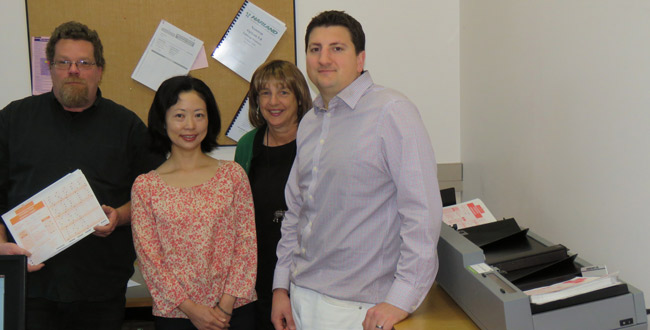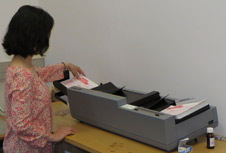
The electronic exam-marking hub … (from left) Desktop Support Specialist Dean Johnstone holding a multi-choice exam form, Yoko Kurata, manager Philippa Hawker and specialist Matt Hall, beside the machine that scans completed exam forms.
New features in the electronic marking service for multiple-choice tests, assignments and exams include providing students with information about the answers they got wrong, Information Technology Services Desktop Support Manager Philippa Hawker says.
Usually students receive a reference to a textbook page or the relevant lecture – whatever option the lecturer chooses in the feedback request form supplied to Information Technology Services (ITS) Desktop Support.
That feedback option was formally added to exam marking services this year and other initiatives include recent updates to the range of options for sorting results, and an easy way to import them into an Excel spreadsheet.
ITS is also working with Uniprint to develop a form that can be printed on campus, to reduce costs.
Marking mission

At work … Yoko Kurata scanning exam forms complete with answers.
ITS marks about 300 exams and tests every year. The largest classes using the service are first-year Health Sciences, which involves about 1800 students, Ms Hawker says.
ITS supplies those results as quickly as all the others, within two days of receiving the answer forms – unless the forms are not in the correct format, are damaged or are incorrectly filled out, which is why ITS officially says receiving the results can take up to five days.
Departments from all the University of Otago's academic divisions use the marking service and ITS also processes nursing exam results for the Otago Polytechnic.
Making change
“Feedback is always welcome because we are always looking to add features to improve the service,” Ms Hawker says.
The marking service was much more labour-intensive when she started working at the University of Otago in 1976.
Data entry operators had to capture the answers to the questions using punch card machines, then the first Macintosh computers arrived but an operator still had to enter the data and another operator had to verify it.
Now, students answer exam questions on specially designed forms, then ITS staff scan the forms using optical mark recognition software that transforms the results into text.
The text is imported into specialised software, which not only compiles the results, but also provides statistics about the exam, including the degree of question difficulty, how many students answered each question correctly, and the percentage of the class that answered correctly.
Requesting the multi-choice exam-marking service is as simple as filling out a form on the ITS web page, on the University's website.